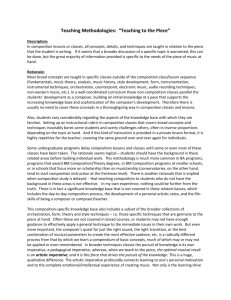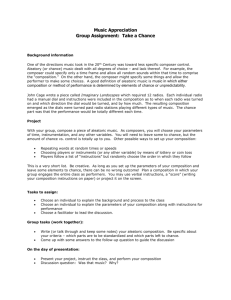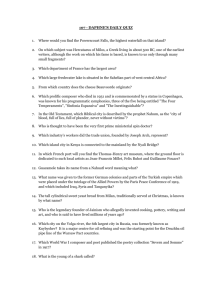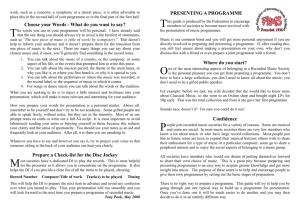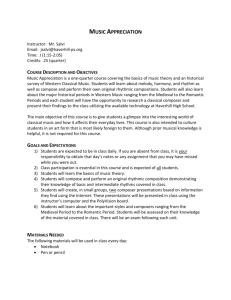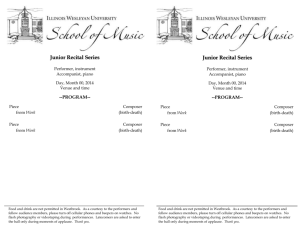Triskaidekaphobia Volume II Welcome to the Disk Coordinator C13
advertisement
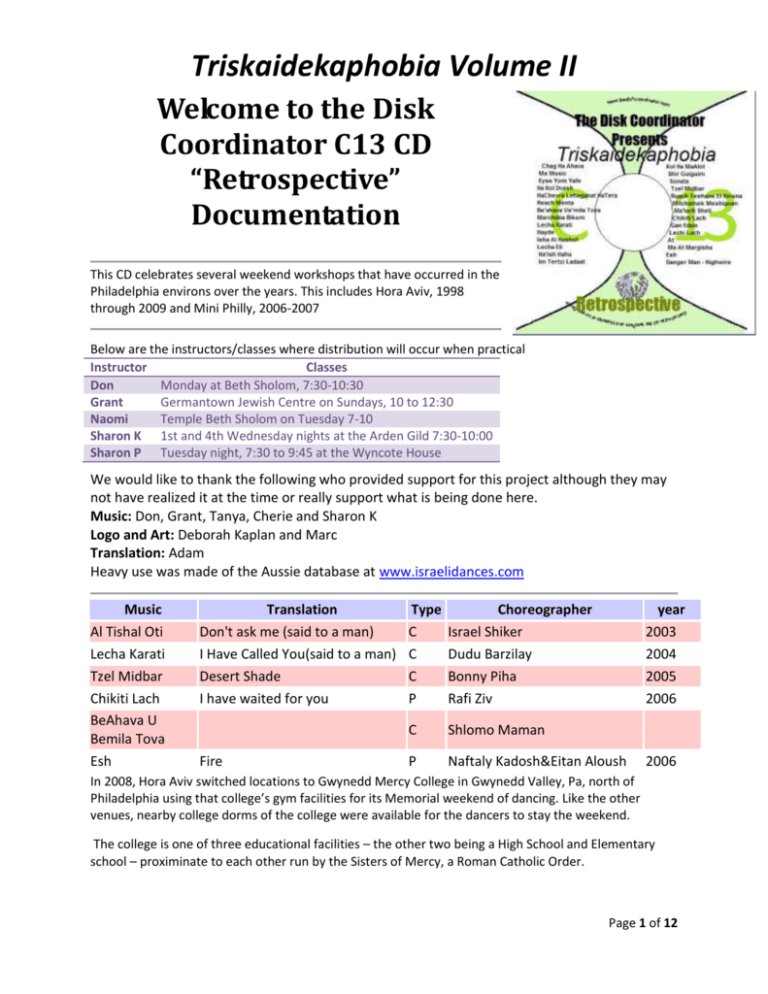
Triskaidekaphobia Volume II Welcome to the Disk Coordinator C13 CD “Retrospective” Documentation This CD celebrates several weekend workshops that have occurred in the Philadelphia environs over the years. This includes Hora Aviv, 1998 through 2009 and Mini Philly, 2006-2007 Below are the instructors/classes where distribution will occur when practical Instructor Classes Don Monday at Beth Sholom, 7:30-10:30 Grant Germantown Jewish Centre on Sundays, 10 to 12:30 Naomi Temple Beth Sholom on Tuesday 7-10 Sharon K 1st and 4th Wednesday nights at the Arden Gild 7:30-10:00 Sharon P Tuesday night, 7:30 to 9:45 at the Wyncote House We would like to thank the following who provided support for this project although they may not have realized it at the time or really support what is being done here. Music: Don, Grant, Tanya, Cherie and Sharon K Logo and Art: Deborah Kaplan and Marc Translation: Adam Heavy use was made of the Aussie database at www.israelidances.com Music Al Tishal Oti Lecha Karati Tzel Midbar Chikiti Lach BeAhava U Bemila Tova Esh Translation Don't ask me (said to a man) I Have Called You(said to a man) Desert Shade I have waited for you Fire Type C C C P Choreographer Israel Shiker Dudu Barzilay Bonny Piha Rafi Ziv year 2003 2004 2005 2006 C Shlomo Maman P Naftaly Kadosh&Eitan Aloush 2006 In 2008, Hora Aviv switched locations to Gwynedd Mercy College in Gwynedd Valley, Pa, north of Philadelphia using that college’s gym facilities for its Memorial weekend of dancing. Like the other venues, nearby college dorms of the college were available for the dancers to stay the weekend. The college is one of three educational facilities – the other two being a High School and Elementary school – proximinate to each other run by the Sisters of Mercy, a Roman Catholic Order. Page 1 of 12 Triskaidekaphobia Volume II The college started out as a woman’s educational facility in 1947/48 similar to Wilson College and Neumann College (now a University but starting out under a different name) but branched out into coeducational facilities due to federal regulations. Prior to the property being transformed into a set of educational components, it was an estate, like many at the time in the Philadelphia suburbs, combining a manor house with limited farming. This estate, Willowbrook, has an interesting history and the dancers could have discovered that history, although we doubt that any were so aware and even less interested, by walking up the hill to the administrative offices of the college housed in the manor of the estate prior to the College’s creation. This manor house has been renovated and all sorts of offices are in its residence including public relations. The family that originally built the house has all sorts of historical linkings to Philadelphia and the world and to some degree links this web site and all its components. Thomas Bond was a well known ornithologist in the 1800’s and scion of the family that founded the estate of Willowbrook. The Bonds were one of the early settlers of the Philadelphia (and environs) area and Bond is a name that derives back to the Norman conquest of England (one of the French knights). At the turn of the last century (1900 or so) he and his wife and several children occupied this estate. The wife died unexpectedly and Bond never recovered from the shock. Without his wife and her support, just prior to World War I, Bond sold the estate and moved the family to England. It was the new owner who eventually, some 30 years later, sold the property to the Roman Catholic order. The son of Thomas Bond returned, during the 1920’s, back to Philadelphia having dev eloped a British accent in the interval which he never relinquished. Like his father, he became a self taught ornithologist and began a very successful and fulfilling career with Philadelphia’s Academy Of Natural Sciences. On multiple occasions he would lead expeditions for the Academy to various areas of the world, but soon his interest would center around Jamaica where he was the first to discover that Island’s (and its environ’s) unique quality. Birds from North and South America would nest there at different times of the year (during winter in the respective continents) and in 1936, James Bond (the name may sound familiar but not necessarily in this context) published the seminal book for bird watchers in the Caribbean, Birds Of the West Indies, which became a kind of bible for birders, as they call themselves, throughout these islands One avid birder and owner of the ornithology book, a journalist who spent two months of the year in Jamaica every winter, thought this author’s name very appropriate when he was writing his first novel in 1952 and casting about for a name for his hero (or so this journalist, Ian Fleming, would relate although it is felt by many that Fleming was aware of the name from other sources and used this as a convenient excuse). We assume that it is in the context of Fleming’s books and the movie adaptations, and not through ornithology, that the name James Bond is familiar to you. Someone said that this web site and these CDs have attempted to marry Israeli dancing and James Bond and done so quite unsuccessfully. We would certainly not disagree with that conclusion although we do keep trying. But, almost inadvertently, in 2008, the Hora Aviv camp was effortlessly able to successfully marry these together and not even be aware of this success. And, we say, good for them! Shir Ga[']aguim Gan Eden Song Of Yearning(H) Garden Of Eden(H) C P Avi Levy Naftaly Kadosh 2007 2007 Page 2 of 12 Triskaidekaphobia Volume II The two dances above, Shir Ga’aguim and Gan Eden, were first demonstrated in the Philadelphia area by their choreographers, Avi Levy and Naftaly Kadosh, during the 2007 Min Philly camp. The camp occurred on the July 4th weekends of 2006 and 2007 and was the concept of Eitan Aloush, a Philadelphia resident, who is also an Israeli dance choreographer (he is credited with Esh which was also debuted at the camp in 2007). So, Eitan, Avi and Naftaly, joined by Edo Israely in 2007, taught their own choreographed dances to the participants of Mini Philly in those two years. Sonata To sound (s) Mali Lopton&Moshe C Ira Weisburd Hakol Dvash All is honey P Avi Peretz 2005 Mazar Chag Ha[']Ahava Festival of love C Rafi Ziv 2005 Shoshan Ms Music (Miss Ms Music Music) C Oren Shmuel 2006 Mizrachi;singer:Sarit Hadad Isha Al Hachof C 2004 2005 Composer:Doron Mazar;;Singer:Doron Composer,lyrics and singer:Gabi Composer & Lyrics:Henry Wli Ms Music, a song written about Sarit Hadad herself, was demonstrated by Kobi Michaeli at Hora Aviv 2006. We mention this because for most attendees of this camp throughout the years, the years it was resident at Neumann College, now Neumann University, probably were the best. Based in the student center at the gym that at the time the varsity basketball teams used for their games, the composite ratings of the sound system, the administration, the dining room and the residence halls probably were at their highest and most enjoyable for this camp. 2006 was the last of 4 years at Neumann as the camp was situated there from 2003 through 2006. We would like to report, for those interested, that the Neumann Knights and Lady Knights now have their own facility in which to compete in basketball as the school completed construction of a facility next to the residence halls shortly after Hora Aviv’s departure in 2006. Eizeh Yom Yafe[h] Kol Habachurim HaChevra Lehaganat HaTeva Rei'ach Menta What a beautiful day C Kobi Michaeli 2005 Composer,lyricist, singer:Amit Tzach All the Guys C Zeev Benedict 2004 Composer:Shmuel Elbaz;;Singer:Julieta; The society for the protection of nature C Gadi Bitton Composer&Lyricist:Shmuel 2006 Chizak;Singer:Ariel Zilber Scent of mint C Rafi Ziv Thanks for Meir Shem Marhaba Bikom C coming(a)(Moroccan) Tov 2004 Composer,lyricist and singer:Tizshma Yalmaz Hayde 2009 Gispan;singer:shlomi shabat C Gadi Bitton 2003 Composer:Asli Yantor;Lyrics:Yosi Hayde was taught by Yaron Ben Simchon at the last Hora Aviv camp in 2009. This camp was situated at Wesley College in Dover Delaware. The location itself did not help as shore traffic to points on the Delmarva Peninsula made travel to and from Dover for most attendees a long and dragged out affair. Page 3 of 12 Triskaidekaphobia Volume II The camp itself was more poorly attended than previous camps and this may have been the result of the onset of what is called the great recession. Those who did attend were moved from the gym, where dancing was supposed to occur, into the teacher’s lounge. Like many of the camps, most of the music and dances were quickly forgotten as the weekly Israeli dance sessions failed to include the music into their ongoing repertoire. But Hayde (Heidi in Hebrew) has survived becoming a favorite of younger dancers in the Philadelphia area. Lecha Eli To you my God C Shlomo Maman Ha'Ish HaHu That man C Kol Ha Maalot virtues of ascent Composer:Yair Gadassi;;Chaim 2002 Israel Kobi Michaeli&Gadi Composer and lyricist:Ahuva 2006 Ozeri;Singer:Yehudit Ravitz Bitton C Victor Gabay 2006 Lyrics and singer:Yosi Azulay In 2007 Hora Aviv moved west into the Lancaster area. The weekend event took place at Millersville University in the city of Millersville, a suburb of Lancaster. Millersville is one of 14 Universities in the Pennsylvania State System of Higher Education. For those not familiar with this, this association starts out early last century with a combining of several “normal” schools into a state system. “Normal” was a term used for teaching institutions and before long this system was designated as the Pennsylvania State Teaching College Association. With the State financial backing, most of these schools enlarged both in size and curriculum content to the point that the present name for the association was established in 1983. Many of these institutions now offer graduate work and therefore, like Millersville, are deemed Universities. Millersville’s specialty over the years has been in business and the student body that attends this University generally rate and rank highest as to performance and durability throughout the PASSHE. In one study, for instance, Millersville far outranked the other 13 members of the association in 4 year graduation rates. One thing that wasn’t brilliant as far as dancing at this University would prove is the assignment of the obsolete Gym (to be demolished shortly thereafter) as the venue for dancing on that Memorial day weekend. This was one of the hottest Memorial day weekends on record but this gym had no air conditioning. Everyone who attended remembers this situation. One positive note was the food. Being in the heart of Amish country, everyone remarked as to how well the food services were that weekend. While this couldn’t fully compensate for the lack of air conditioning, it did provide for pleasant experiences outside of the assigned hours for dancing. Haruach Teshane Et Kivuna Mitchamek Meshigaon The wind changes direction P Gadi Bitton Not Crazy P Dudu Barzilay 2004 Composed, lyrics and sung by Yaron Cohen 2009 Composer:Uri Zach;;Singer:Harel Skaat Wilson College, in Chambersburg, Pa southwest of Harrisburg, is one of the first Women’s colleges in the country and the name is attributable to its first donor, Sarah Wilson, whose funding helped with the creation of the school in 1869. In recent years, to meet the criteria set by Government regulations Page 4 of 12 Triskaidekaphobia Volume II banning bias, the school has created a graduate and certificate program that is attended by both men and women. It also has an interesting distinction of being one of perhaps 200 colleges in the country that offer extensive equestrian courses including a major in Equine Journalism. It is no secret that Israeli dance (and dance in general) attracts more women than men. So, whether to follow the gender bias (or perhaps to just follow the horsey set), it was appropriate that the first three Hora Avivs (at that point called Dance Washington) occurred at Wilson College through the years 1998, 2000 before moving eastward into the Philadelphia area. Ma'lach Sheli My Angel P Yaron Malichi 2004 Composed, lyrics and singer:Yaron Cohen Lechi Lach Take a walk P Gadi Bitton 2005 Medina At You P Avi Levy Shlomo P Maman 2000 Composer and lyricist:Chaim Ochana Ma At Margisha What do you feel composed. lyrics and singer:Avihu 2009 Composer and Lyricist:Michael Vaaknin In the A13 and B13 documentation, a timeline was established dealing with Danger Man through the Prisoner. Much is made of this transformation of the character of John Drake and most would say it is attributable to the iconoclastic personality of Patrick McGoohan, the actor who played both parts. No doubt this was true but there may be other reasons that should be considered. In addition to the above, the kicker for this C13 disk, known as the ighwire version of Danger Man, composed by Edwin (Ted) Astley, is of interest due to its tangential relationship with at least one TV show which might be the center of structural changes as to how TV shows were televised in the 60's era (not to mention be of interest to this web site and its creator). Astley, who is the father in law of Peter Townsend of the Who, writes this theme for the second season of Danger Man which we think occurs sometime in 1962/1963. 10 years previous he creates the Ted Astley band, which was well recognized throughout England after a time. When he writes this Highwire theme, he has already turned his attention to becoming a specialist in music scores for TV shows. This is very similar to another musician studied in these disk coordinator CDs, John Barry Prendergast, whose initial claim to fame is the John Barry Seven but who would also become involved in movie (as opposed to TV) themes. But, we come to the question, what was on TV in the late '50s, early '60s and what does it tell us about the evolution of TV media over the years? We should begin by explaining that television is really an extended use of radio using two (or more) radio sources. Conceived while cultivating potatoes, so the legend has it, by Philo Farnesworth in 1927, television was in its infancy by the onset of World War II. It did have some successes by that time having been used by the Germans to televise the 1936 Olympics and by RCA to broadcast Yankee games to a very small audience in greater New York starting in 1939. But commercial television, being a source of 2 or more radio signals, was banned by all the participants of World War II for security reasons (although its cousin, Radar, was greatly developed and utilized during that war). By the war's end, television is ready to boom in the United States. But, besides Yankee (and Phillies) games, what do you put on a medium such as this. At the start everything is live from comedy shows to Page 5 of 12 Triskaidekaphobia Volume II game shows to drama. Comedy centers on those personalities popular in commercial radio and so we have Jack Benny and George Burns continuing their radio shows but on this new media. Game shows also were popular and generally were composed of several star panelists doing or guessing something. It also offered the biggest irony by having Philo Farnesworth as a contestant on I've Got A Secret (his secret, by the way, was that he had invented television). Variety shows abound, at first live then taped, and you can look at the Bob Hope specials or the Carol Burnett show (not to mention Ed Sullivan) as examples of this. But something is missing here as far as the television we knew in the late 1950's, early 60's is concerned. This is nothing special here that you did not have on radio or at the movies on either side of the Atlantic. In the case of non-variety type of shows, there was limited opportunity for guest stars. You could hardly have multiple guest stars, or a change of scenery, in Jackie Gleason's The Honeymooners. Your show of shows also would have been limited by location and the addition of additional personalities. Even Gunsmoke needed established sets as it was constituted at that time. Luckily for the baby boomers, the first generation to be affected by this media, this is about to change. In the late fifties comes the western serials like Gunsmoke but even more importantly is another western series, Have Gun Will Travel. Richard Boone, designated by his card as Paladin, awaits adventure while lazing in San Francisco. With a telegram, every week he rides to a new location in the west, confronting a new villain and possibly assisting a new heroine. Every week is different from the previous week. You now have the model for many television series from the late 50's through the late 60's. Paladin is emulated by Maverick (the hero travels town to town looking for a card game), all sorts of detective series including Peter Gunn, Mickey Spillane and various look alikes from Warner Brothers where our heroes in their offices await new cases. In England it was the same. And, the previously written up Danger Man falls into this category of the hero episodically moving from his operational center. What is the appeal of this type of programming and why at that point in time. The timing may be answered to some degree by advances in the technology of taping medium which possibly allowed for the quick filming needed for these types of series. In the past the only copying was by magnetic wire which was inefficient and whose main basis was music. Now, used first by the computer industry as mag tape -and its equivalent as video tape, the industry could video tape and easily record images and sounds. Live broadcasts were no longer required and there was now a quick way to capture the images of different sets. The programs indicated above were probably the first to use this medium in this way although elements of photography, still the standard for movies, were still probably the primary means of capturing images for the rest of the industry. (Although Alfred Hitchcock used this videotaping technique when creating Psycho in 1960 and this may have been the first movie to be filmed as if a TV program) Given the capability to quickly film these scenes, we have cowboys (Paladin, Maverick, Cheyenne), detectives(77 sunset strip, Bourban Street Beat) , secret agents (Danger man, The Man from Uncle) and Lawyers (Perry Mason) emanating from their office into adventures dealing with new clients, women, villians, etc each week at a new location which was nothing more than sets in the back lots of the studios. For the audience, it was something new each week with characters introduced who did not overstay their welcome given that by the next week (and generally by the point where the ending credits ran) they were gone. Page 6 of 12 Triskaidekaphobia Volume II But why stop with specific home offices. The ultimate to this type of storytelling and TV adventure is to have a show centering on someone who neither has or needs an office and has plenty of reason to be on the move, on a weekly basis perhaps, from place to place. Three TV shows, two in the US and one in Britain, are created to fill this type of need and type of hero. At the heart of the US shows is Roy Huggins, a novelist who joins Warner Brothers in the late 50's and then goes independent (while suing Warner Bros for copyright infringement). As an independent, he creates the Fugitive and Run for Your Life. The Fugitive, as you probably know, is about Dr Richard Kimble, found guilty of killing his wife, but who escapes and in his pursuit of the real killer, the one armed man, while being pursued by Lt Girard, needs to move from place to place very rapidly and often. Run for your Life involves a highly successful lawyer, Paul Bryan, who being told that he has a fatal illness and less than 2 years to live, decides to live life to the fullest without the constraints most of us have in doing this as to money and reason. Among the most ironic aspects of this show is that its character, having 2 years to live, appeared in 4 years of TV production. These types of programs seem ideal for television of that era for the reasons mentioned above. But what's the downside? You need lots of scripts with supposed new ideas per the season episodes or the audience will tire even of this. Even so, in many cases scripts are duplicated with minor changes to be used in both shows. For any television series, this type of plagiarism is not unique for as Fred Allen once said, "Imitation is the sincerest form of television." In England, a different tack is applied and it is here where Edwin (Ted) Astley plays his part. ITC is the independent network in England at that time when English broadcasting is dominated by several BBC channels. ITC is run by the very famous Lew Grade, mentioned in both the A13 and B13 documentation. Grade already has a hit in Danger Man but he would like a second series (if not more) of similar success. Perhaps he orders that similar programming to that described above be developed, one where the hero is just dealing with different locations and people each week. Or, perhaps, it's happenstance. But, in one way or the other, an idea is developed pertaining to a character without a home base with the added plus that a whole set of already existing literature is available about him to produce scripts. From pulp fiction, if you will, a character is investigated about whom his creator has written a vast amount of stories. This character, a kind of devil-may-care, humorous loner, looks at himself as a kind of modern Robin Hood. He has already been the basis of a set of successful movies (none of which literally used the author's books or words, but still helped define this character even more) during the late 30's into the early '40s and these movies are quite interesting to examine even today as they become the vehicle for the beginning stardom of the actor, George Sanders. Starting in 1945, this character was transported to radio and Vincent Price had the lead. The radio programs dramatically recreate this character's creator's original stories. Only one thing is appropriated from the series of movies indicated above - the character's musical theme song The creator of this modern day Robin Hood was said to have been born in China to a Chinese surgeon and English mother. Immigrating to England after WWI, he at random chooses the last name of Charteris and so the identity of Leslie Charteris is born. Although he tries several occupations, he finds that he is a natural writer and we're sure you know the rest of this story as he creates the character in question, Simon Templar, aka the Saint, who acts like a modern day Robin Hood. Page 7 of 12 Triskaidekaphobia Volume II Someday, on some silly and insignificant web site, we will produce some documentation about The Saint. And his creator, like all the authors these CDs have dealt with, has an interesting life story to tell. But, we are interested in how the televised edition of the Saint fits into these CDs and in some way deals with the evolution of John Drake into the Prisoner and into the theme music that is C13's kicker. First, Edwin Astley mentioned above, creates a new theme for the upcoming Saint television series in 1962. He is probably more famous for the television Saint theme than he is for the Highwire theme that is on this CD’s last track. Like all musicians, Astley borrows ideas for his theme songs and you can discern some similarities between the Highwire theme and initial Saint TV theme. Interestingly enough, Astley will incorporate music themes from the Saint movies in a later re-creation of the Saint TV theme, but that's a story for another day. Another tie is the selection of the actor to play the Saint. During the early 60's one British male model of fashion, makes the transition to acting but in the United States. For its last season, he joins the cast of the aforementioned Maverick as Beau Maverick, a part of the British side of the clan so it is claimed. His part is not really significant but he does impress with his ability to handle humor with or without dramatic situations. This proves useful when he auditions for the lead part in this sister series to Danger Man, The Saint, and he will play the part of Simon Templer successfully with great popularity worldwide, including in the United States, until the series is terminated at the end of the 1969-1970 season. You are no doubt asking yourself whether this ended this actor’s career in the performing arts? Did he return to modeling the finest of British suits? Not to worry! You may know of him through another film series he takes part. It turns out that by 1972, a very famous movie series, one that has on occasion been chronicled by the kickers of these CDs, was in need of an actor to carry on the series given that the original star had decided to pursue other acting parts. And so it is Roger Moore, part of the fictional Maverick clan and the embodiment of the Saint, Simon Templar, who in 1973 straps on the Berns Martin Triple draw holster containing the Walther PPK (it would have been a Smith and Wesson in the books) and smartly reports to Miss Moneypenny and their boss, M, in the fictional offices of MI9 as the new James Bond, 007 as he stars in the movie, Live and Let Die. Now, this is quite a bit of trivia in terms of the linkages between authors, TV series and the like. But, what about the transformation of Danger Man to the Prisoner? As mentioned in the beginning of this discussion, we might be seeing the recognition that television series were about to change again. The late 60's and early '70s show a change in direction of this media. It is no longer the Roy Huggins model that is followed. Set pieces in specific locations become the norm again and you can see this through the years in Mash, ER, Knots Landing, Dallas, etc which returned TV to the formula of set location with an ensemble cast and limited guest stars. With John Drake transported to the Village, we now have a series set in a location, strange as the location and the people within it might be. There probably were many reasons for McGoohan's tiring of playing John Drake and his wish to play No. 6. We've discussed several of these reasons in the prior A13 and B13 documentation. But, McGoohan, if one listens to interviews with those who worked with him during this time, had an interest in the evolution of television media. Perhaps this was his way of moving the process along at least for his show. Therefore, it is with great pleasure that we present as the kicker to the C13 disk the theme song for the British TV series, Danger Man as originally done by Edwin Astley. This becomes known as the Highwire Page 8 of 12 Triskaidekaphobia Volume II version. In listening to this theme, keep in mind that it doesn't stand alone: it is part of a set of links that help to tie many things together - maybe not to you, the reader, but at least to the one person writing this documentation. Danger Man Theme knicknamed Highwire Bob Leaper Orchestra 1964 Edwin Ashley Page 9 of 12 Triskaidekaphobia Volume II Welcome to the Disk Coordinator D13 CD Documentation This CD is a compilation of older music found on Sharon K’s computer. The selection was based on timing: music selections were sorted in ascending order by duration of time and then added to the CD until capacity was maxed out. Therefore, with 35 tracks (34 Israeli and the kicker) this may be the most tracks ever for a CD of this type. Below are the instructors/classes where distribution will occur when practical Instructor Don Grant Naomi Sharon K Sharon P Classes Monday at Beth Sholom, 7:30-10:30 Germantown Jewish Centre on Sundays, 10 to 12:30 Temple Beth Sholom on Tuesday 7-10 1st and 4th Wednesday nights at the Arden Gild 7:30-10:00 Tuesday night, 7:30 to 9:45 at the Wyncote House We would like to thank the following who provided support for this project although they may not have realized it at the time or really support what is being done here. Music: Don, Grant, Tanya, Cherie and Sharon K Logo and Art: Deborah Kaplan and Marc Translation: Adam Heavy use was made of the Aussie database at www.israelidances.com Music Nigun Atik Klezmer Typ Choreographer year e Ancient Melody C Rivka Sturman 1955 C Translation Composer and Lyricist:Effi Netzer Simchat He'amel The laborer's joy C Tzadik Katamar Hora Nirkoda Haroa Haktana As Righteous as C a palm tree Let's dance the C Hora Little C Shepherdess Music Jonathon Gabay 1965 Yo'av Ashriel 1958 composer and lyricist:Mark Lavry Composer:Moshe Wilenski Rov Brachot Many Blessings C Leah Bergstein 1958 Sheleg Al Iri Snow on my city C Bentzi Tiram 1974 Composer&Lyrics:Metitiahu Shelem composer:Naomi Shemer Page 10 of 12 Triskaidekaphobia Volume II Hora Medura Erev Ba Sovevuni Campfire Hora At Evening Spin around C C C Yo'av Ashriel Yo'av Ashriel Yo'av Ashriel 1963 1960 1957 Taba location C Moti Elkins 1989 Composer & lyricist:Shoshan Jacki Benson Eretz Eretz land, land C Yankele Levy&Shlomo Bachar 1974 composer & lyricist:Shaike Paikov Harmonica musical instrument C Rivka Sturman 1945 Composer:Mordechai Zeira;Lyricist:Yaakov Orland A bit of soul C Israel Shiker 1990 Composer:Chanan Yovel;;Singer:Uri Fineman C Shmuel Cohen 1949 C Yo'av Ashriel 1972 Tipah Neshama aka Tnu Tipah Neshama Hora Mamtera Korim Lanu Lelechet Hora Habikaa Ahavat Ha'chayalim Na'aleh Na'aleh[Naale Naale] Sham Harei Golan Sula['a]m Ya'akov aka Mal'ach Misulam Yaakov Yihiye Beseder Composer:Joel Walbe Composer:Aryeh Levanon Composer:Effi Netzer C C Shmulik Gov Ari 1983 C Shmulik Gov Ari 1986 composed and lyrics by Avihu Medina There's the Golan C Mountains Jonathon Gabay 1971 Composer:Norma Shemer Jacob's Ladder C Jonathon Gabay 1972 Composer:Nurit Hirsh;lyrics:Yoram Taharlev It's OK C Shmulik Gov Ari 1992 Composer and Singer:Avihu Medina Composer:Shlomo Shai Sapari C Kulanu Bamitzad (Russian Red We of the parade C Army theme) Of the Yam Tichoni Mediterranean C Sea Moshe Eskayo 1970 Chayim Shiryon 1986 Used in parades for the Russian Army Shlomo Maman 1991 Composer:Yehuda Poliker Be'pundak Katan In a small Inn C Avi Peretz 1988 Kol Nederai All my vows C Shmulik Gov Ari 1988 Ha'ir Beafor City in Gray C Composer and singer:Beni Berman Composer:Yair Klinger;;Singer:Haim Moshe composer and lyricist:Norma Page 11 of 12 Triskaidekaphobia Volume II Shemer Laner V'libsamim Balada Lama'ayan Hora To the candle and its spices Ballad to the Spring (Dance step) Yedid Nefesh Soul mate Shir Eretz P Amnon Sha'uli 1976 C Shlomo Maman 2003 C Shlomo Maman 1982 C Jonathon Gabay 1971 Song of the land C Shlomo Maman 1984 Composer:Moshe Wilenski Composer:Ehud and Sara Zweig Composer:Alexander Argov;Lyricist:Natan Yonathon At first this disk was not planned and only became a part of these packages at the last moment as additional music became available. Already established was the Danger Man, Secret Agent, Prisoner axis, so what do you use as a kicker for a fourth CD when three were planned. It was decided to use one of the great themes of one of the great movies of the middle of the Twentieth Century, the Third Man. Everything about this movie is interesting starting from its conception – a paragraph written on an envelope by the great novelist, Graham Greene and handed to the great director, Carol Reed, while both are having lunch – to its production and its selection of actors that included Joseph Cotton, Trevor Howard and Orson Welles. The selection of the artist to create the music, Anton Karas, is also a fortuitous fluke. Movies are generally filmed on stages at studios depicting the background by these sets. General scenes are shot beforehand in the area the movie is supposed to be happening. In surveying Vienna for location and background scenes before the shooting of the movie was to begin, the director Reed walked into one of the many Coffee Shops/Bars/Beer houses that populate the city and heard the musician, Anton Karas, playing the zither, a kind of level harp, and on the spot requested Karas to score the movie. Karas’ main theme, the kicker for this D13 CD, was an international sensation when it first appeared coincident with the movie release. The real name to the song is the Harry Lime theme, Harry Lime being the villain of the movie as played by Orson Welles. However, soon the distinction between Harry Lime and the Third Man of the movie name disappeared and today this song is remembered as the Third Man theme, appropriate enough given that it is played while the titles of the movie are running. We hope you enjoy the kicker to D13, the Third Man theme composed and played by Anton Karas. D13 The third man theme (Harry Lime Theme) Anton Karas The C13 and D13 disks make up Triskaidekephobia, volume II. Volume I, released last year, is composed of the A13 and B13 disks. Not that it means much from a legal perspective, but these disks have been created for educational purposes in the study of Israeli dance (and possibly the life of Ian Fleming, among others) These CDs have been delayed by some 9 months or so and the materials for their creation have been stored for so long that they became integral components of fault lines. We apologize for any earthquakes we were responsible for when the materials recently were finally moved into place This is the end of the 13 series of Disk coordinator CDs. You can see this and other added documentation on the web site, www.thediskcoordinator.com, link to TDC CDs, Docs and Explanations. The disk coordinator expects to be back in action sometime in the future. Page 12 of 12

